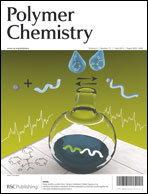Unexpected correlations have been found between structural parameters and glass transition temperatures (Tg) of poly(N-vinylimidazole) (PVIm) and crystallinity of poly(tetrahydrofuran) (PTHF) in a series of novel, unique PVIm-l-PTHF amphiphilic conetworks synthesized in broad composition ranges via free radical copolymerisation of VIm and semicrystalline, methacrylate-telechelic PTHF macromolecular cross-linkers with varying Mn from 2170 to 10 000 g mol−1. Differential scanning calorimetry (DSC) investigations revealed microphase separation between the covalently bonded PVIm and PTHF components, that is two distinct Tgs corresponding to the respective polymers (PVIm and PTHF) were obtained in these optically clear, transparent materials. Complete microphase separation, i.e. absence of mixed phases, was also confirmed by solid state NMR measurements. The Tg of the PVIm phase significantly decreases with increasing PTHF content, and Fox–Flory type correlation was surprisingly found between the Tg of PVIm and its Mc (average molecular weight between cross-links). This striking finding indicates a unique, unpredicted scissor effect of the macromolecular PTHF cross-linker in these materials, i.e. with respect to glass transition, PVIm behaves as individual chains between cross-links. The molecular mobility in the PVIm chain segments obtained by solid state NMR investigations shows a similar trend as a function of Mc. In the DSC thermograms, the semicrystalline PTHF has a sharp endothermic melting peak (Tm) indicating partial crystallisation of this polymer. It was found that the Tm and the crystalline fraction (Xc) of the PTHF phase are suppressed by even a minimal content of PVIm phase in the conetworks. Even complete diminishing of Xc occurs in conetworks with lower than 40 wt% PTHF of the lowest Mn (2170 g mol−1). Unexpectedly, Tm linearly decreases with Mc in conetworks with constant Mn of PTHF. These data indicate that the decrease of both Tm and Xc of PTHF is not only composition dependent, but the MW of the macromolecular PTHF cross-linker and the Mc of the PVIm component also have effects on these parameters. These results also indicate that chemical bonding of polymer chains in conetworks yields novel materials with unprecedented property variation. This provides unique opportunities for fine tuning of the investigated fundamental material properties, i.e. Tg, Tm and Xc, within certain ranges in the novel PVIm-l-PTHF amphiphilic conetworks by selecting the proper synthesis parameters, that is, composition and MW of the telechelic PTHF macromonomer cross-linker.


 Please wait while we load your content...
Please wait while we load your content...